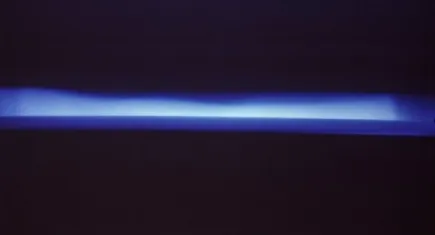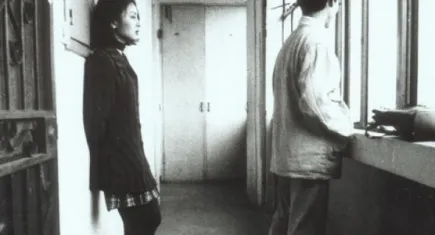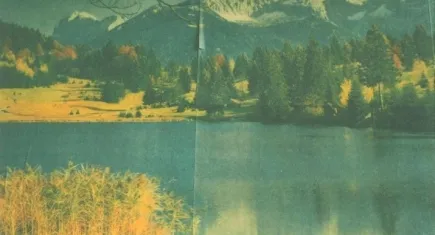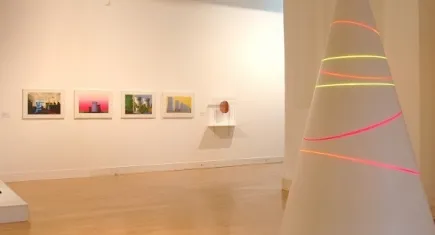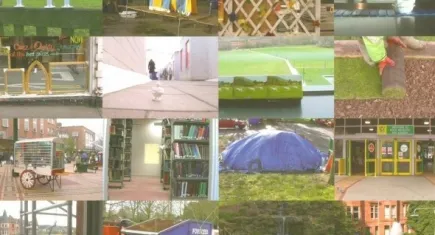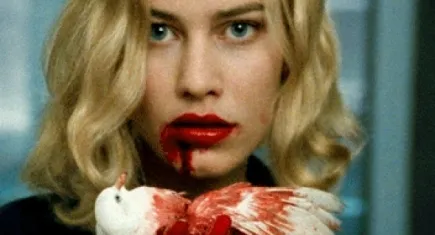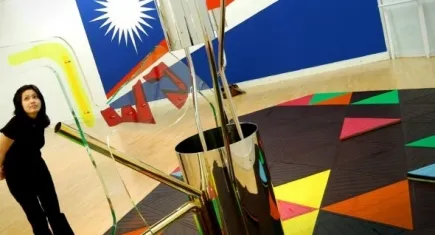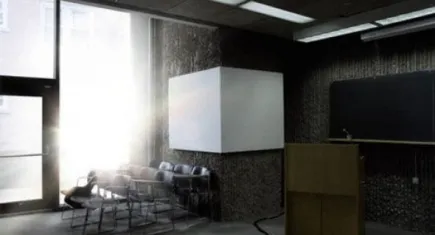Mead Gallery Exhibitions 2005
Garry Fabian Miller: Real in the World
A Mead Gallery Exhibition
Thu 3 Nov – Sat 3 Dec 2005
Garry Fabian Miller had a solo exhibition at the Mead Gallery in 1992. Over the years, several of his ‘camera-less photographs’ of natural phenomena have been acquired for the University of Warwick Art Collection. This exhibition examines his more recent photographs.
Central to photography is its relation to the real, its potential – identified by Susan Sontag – to ‘usurp reality’. Much of western philosophy holds that the real transcends description and is that which exists in itself. The real in photography is therefore not so much the reproduction of appearance but the way a photograph becomes the indexical object. Equally, the ‘real’ is applied to modernist painting in terms of the self referencing of its formal values.
For twenty years, the cameraless work of Garry Fabian Miller has occupied its own territory. It is rarely discussed within the context of contemporary photography or indeed of wider contemporary art practice. Commentators concentrate on his use of light, relating it to Turner in whose steps Fabian Miller undertook a residency at Petworth. Other comparisons are made with the American painters of the 1950s, Newman and Rothko, in the way that their works demand attention from the viewer. This exhibition interrogates the work of Garry Fabian Miller within the context of contemporary ideas and practice.
It presents a significant body of work by Fabian Miller and seeks to explore its development. Essential to his practice is the process of extending and developing an image by means of quite small changes, resulting in a body of work that is a series – variations held within a particular theme. In ‘The Originality of the Avant Garde’, Rosalind Krauss argues that repetition is crucial to originality. ‘In developing a template, the paradox of how to be original again and again is solved.’ The processes involved in the development of the work create a language in which they refer to nothing but themselves, rather than statements about things outside the work. Process is the only thing that is ‘represented’ in the work, in itself it is something else – something real.
In making work that appears to subordinate artistic gestures to the process of light crossing film, the relationship of the work to the viewer invites a negotiation of absolute truths rather than everyday concerns. Perhaps it is here that there is a residual unease regarding Fabian Miller’s work. The positioning of the viewer in the face of images drawn from nature and constructed from light can raise notions of evangelicism with the knowledge of the artist’s Christian faith. Critics have dwelled on the relationship of the intense beauty to the ‘mystery’ of the work. However, the bright white cubes of the Mead Gallery and its history of exhibitions of abstract painting, here create a different context for these works, a contemplation of wholly abstract forms created in a medium known for its imprint of figures, objects and places.
Gary Fabian Miller’s work has been seen quite widely over the past five years or so: in commercial and public galleries in one person and group exhibitions, and most particularly as the result of the Petworth House residency in 2000. This exhibition comes at a time when a major monograph is being published by Merrill, and the artist will be curating works from the photographic collection at the V&A to coincide with its launch in 2005.
The exhibition includes the following series of work:
Frozen Water, Harvest (Autumn 1991), Golden Lines/Golden Suns, Delphinium (1990), Red Series, Towards a Solar Eclipse, To Look at the Sun, Night City 2, Light Room.
Yang Fudong: An Estranged Paradise
Exhibition organised by Mead Gallery
Mon 26 Sep – Sat 3 Dec 2005
Yang Fudong has achieved considerable critical acclaim in the last five years. In 2001 his work was shown at the Istanbul Biennial. It was included in the high profile exhibitions of international visual culture at Documenta 11 in 2002, the Venice Biennale in 2003, the Liverpool Biennial, the Moscow Biennial and in exhibitions at major museums and galleries across the world including Tate Modern.
Born in Beijing in 1971, Yang Fudong studied painting and graduated in 1995 from the China Academy of Arts (the former Zhejiang Academy of Fine Arts) in Hangzhou. He now lives and works in Shanghai, a significant film-making centre in the interwar period. Yang has an interest in Chinese films of the 30s and 40s such as Yuan Muzhi’s ‘Street Angels’ of 1937, but although ‘An Estranged Paradise’ is shot in black and white on 16 mm film, its structure and references go beyond those of early Chinese cinema.
An Estranged Paradise is Yang’s first feature film. Set in Hangzhou, Chinas ‘Paradise on Earth’, he began making it in 1995, a time he admits when he and his fellow graduates felt lost. Although he completed filming in 1997, it was not produced until 2002 when it was shown in Documenta 11. It tells the story of Zhuzi, a young intellectual, who succumbs to a strange illness that seems inexplicably linked to the rainy season and disappears with its end. In Yang’s own words, the film stands as ‘a meditation on life’, in which nature seems intimately bound to psychology.
The situation of intellectuals is a recurrent theme in Yang’s work. For most of Chinese history, they have played a leading role. This was challenged during the Cultural Revolution and now, in the emergent capitalist economy, their role is questionable. His films explore the tensions of modern China: of rapid urban expansion and individual alienation.
The film opens with a dissertation about a Chinese landscape artist. As a brush painting is created on-screen, a voiceover lists various rules used to establish harmony between the visual motifs. The film is poetically structured with recurring visual motifs that echo the rules of Chinese landscape painting, but the harmony of the film’s structure offers a subtle contrast to the story of the restlessness of the film’s protagonist.
Even though Yang Fudong’s works have a strong narrative component their message is never clear. Yang creates a string of allusive and ambiguous images, underscored by sound and text. They confirm the confusion and inexplicable feelings of people who have a sense of displacement within their own country, society and time.
Yto Barrada: A Life Full of Holes - The Strait Project
A Touring Exhibition from Autograph, London
Mon 26 Sep – Sat 22 Oct 2005
The Strait Project is a photographic project by Yto Barrada which examines the dreams of North African migrants and their influence on the cityscape of Tangiers, which has become the focal point for the issues surrounding African migration to Europe.
“Even a life full of holes, a life of nothing but waiting, is better than no life at all”.
' Life Full of Holes, Driss Ben Hamed Charhadi, 1964
In its collapse, the colonial dream has left us the heritage of an iniquitous regime of identifying and managing the mobility between the North and the South of the Mediterranean. In this bottleneck, known as the Strait of Gibraltar, visiting rights are now one-sided. This territory of the in-between is marked by the coincidences between a physical space, a symbolic space, an historical space, and finally, an intimate space.
In Arabic as in English, strait conjugates narrowness (dayq) and distress (mutadayeq). In clear weather, the horizon from Moroccan coasts is Spanish; but the Strait has become a huge Moroccan cemetery. This immigration differs from the preceding ones. It has its vocabulary, its legends, its songs and rituals. People no longer say “he emigrated,” but h’reg: “he burnt,” he burnt his papers, his past. The exploits of the burned are everywhere, their stories stoke the desire for elsewhere. An enclave long forgotten by national investments, Tangier is now the city where thousands of hopes come up short. Rather than any nostalgia for an international ghetto, first of all what I want to show is the inscription of this stubborn urge for departure which marks people in this city.
I have sought to suggest the metonymical character of the Strait by insisting in my images on the tension between allegory and snapshot. Strait is another word for the temptation of departure, and a commonplace (which has become a common bond), ceaselessly agitating the streets of Tangier. This slippage gives the streets the form of an imaginary space, which is engulfed by/which engulfs all the obstinate dreams of leaving the country. The would-be immigrant forges a collective identity here, by dint of being legally obstructed from crossing the Strait. This obstacle is not without consequences – this position is one of dispossession and indignity. This new immigration – a temporary, individual movement – is perceived in Europe as being closer to a migration – a massive shift of population. We are in the era of suspicion.
Our Moroccan cities are shaped by urban migrations, but also by and for tourism; two great mass movements which are both directly connected to the machinery of globalisation. This transformation requires a reconfiguration of the geography of differences; new trajectories imply new identities (the rural exodus, the return of emigrant Moroccan workers on their summer visits), identities which themselves are forged in resistance to the domestication of space.
When I take photographs in Tangier, I can hardly ignore the fact that I am in my father’s native city, where my mother came to lose her way. I do not seek to underplay the tension and dangers of departure. Yet I’ve never quite known where I am myself or what history I occupy when I walk through this city. I can photograph all the inhabitants who want to leave it, but myself, I always come back, and I live here in the comfort of the maternal home. In my images I no doubt exorcise the violence of departure, but I give myself up to the violence of return. The estrangement is that of a false familiarity. I photograph temptations, not genuine attempts, in a reportage-like style. As soon as I am back in Tangier, I am once again in a state of absence, I become absent. Perhaps there is a relation between my personal experience and the situation of a population seeking to leave the country, having not found its place there. I began to photograph my mother’s house, the ferocity of domestic relations; and of course, what I find nearby, much closer, are the people dreaming of absence.
Yto Barrada
Liliane Lijn: Works 1959-1980
A Mead Gallery Touring Exhibition
Thu 28 Apr – Wed 22 Jun 2005
The work of Liliane Lijn has long evaded categorisation and, as such, has made her an alternative figure in histories of art. This exhibition takes a broader view of the culture of the 1960s and 70s and, in so doing, places her at the heart of consciousness of the period. The account of the development of Lijn’s work is also an account of this era – the evolving technocracy of France and the United States, the development of the space race and the impetus for mass-produced, democratic art.
Liliane Lijn was born in New York and came to Paris in 1959 to study at the Sorbonne. There she met the critic and member of the Surrealist group Alain Jouffroy and gained access to the circle around Andre Breton. She developed extraordinary drawings of other worlds, employing an iconography of the grotesque and the monstrous.
Lijn also became involved with the group of artists and writers centred around the Beat Hotel in Paris, home to William Burroughs, Allen Ginsberg, Gregory Corso, Brion Gysin, Sinclair Beiles and many others. Burroughs was fascinated by the development of Lijn’s Poem Machines which deconstructed text into vibrations.
The advent of space travel and the sense of a new relationship to place, history and technology informs much of Lijn’s work at this time including a science fiction novel called Time Zone. The play of light and its capacity to dematerialize matter became an increasing concern in her sculptural forms of the late 1960s and early 1970s. Science was recognized as a way of achieving a technologically founded utopia and works like ‘The Hanging Gardens of Rock City’ describe a culture of supreme materialism that starts to look inside itself, ultimately dematerialising into pure energy.
This is the first retrospective exhibition of Liliane Lijn’s early work. It is curated by David Alan Mellor of the University of Sussex who is an authority on twentieth century visual culture and its relationship to broader cultural histories. It is accompanied by a substantial, illustrated catalogue where Professor Mellor discusses Lijn’s work in detail.
Anne Bjerge Hansen: Middle Lands
A Mead Gallery commission for the screens of Warwick Arts Centre
Wed 27 Apr – Sat 25 Jun 2005
‘Middle Lands’ is a series of video works in which everyday events and fleeting moments are depicted. Viewers may glimpse surroundings that are familiar or suddenly recognise elements of the University landscape. These interventions play with the expectations and conventions of the still life in relation to the moving image.
The majority of the ‘Middle Lands’ images are influenced by straightforward observations of object-based events. Many of the pieces include items that were found or purchased from second hand shops. These items are introduced to situations and offer an new purpose to otherwise redundant things.
Anne Bjerge Hansen was born in Denmark in 1965 and is now based in the UK. She studied art in Copenhagen, Sweden and Glasgow and has exhibited work in venues across Europe. Middle Lands was commissioned for the Warwick Arts Centre plasma screens with the support of Arts in Business, in partnership with Parenthesis Design and Marketing Communications in Coventry.
Johan Grimonprez: Looking for Alfred
Touring exhibition from Film and Video Umbrella
Mon 14 Feb – Tue 8 Mar 2005
This large-scale, commissioned video installation explores the filmic legacy of Alfred Hitchcock, focusing on his regular cameo appearances in each of his films. Re-enacting them with the aid of Hitchcock look-alikes, John Grimonprez weaves an unexpected narrative from Hitchcock’s fifty-year trail of walk-on parts.
Gary Webb: Deep Heat T-Reg Laguna
Touring Exhibition from Chisenhale Gallery
Mon 17 Jan – Tue 8 Mar 2005
Using a wide range of materials Gary Webb employs an intuitive visual flourish that retains a seductive sense of mystery. Crucial to Webb’s work is his personal relationship to the materials he finds around him. Webb is fascinated by the contemporary urban environment – a world of highly designed interiors comprising restaurants, bars, leisure centres and shopping malls.
Campus: Nancy Davenport, Rainer Ganahl, Christian Philipp Muller
A Mead Gallery Touring Exhibition
12 Jan – 5 Feb 2005
The unique architectural environment of the university campus is imbued with the legacies of idealism and institutional rhetoric, revolt and tradition, offering a microcosm of society’s principles and aspirations. Built as one of ‘the seven’ new universities in the mid-1960s, The University of Warwick was founded during an optimistic period of liberal thinking, when the drive towards educational reform was matched by a dynamic architectural and social impetus.
To mark the 40th anniversary of the founding of the University of Warwick, the first exhibition developed by the Mead Gallery in 2005 introduces three artists who have each produced coherent bodies of work that engage with the social, architectural and institutional histories of universities.
Commissioned for the University of Luneburg in Germany, Christian Philipp Muller’s The Campus as a Work of Art surveys the spatial layouts of a hundred campus universities, from prototype institutions such as the University of Virginia: a self-contained ‘ideal’ community built by Thomas Jefferson in 1817, to Ohio State University, whose Wexner Center for the Arts suggests the way in which universities have seen the arts as a conduit, orientating them towards the world at large. Muller categorises these spaces in an analysis of the ways in which Universities formulate their institutional identities, from Model Universities to Universities as the Wellspring of Society.
Nancy Davenport’s Campus series of digitally manipulated photographs shot at universities in the USA and Canada, frames melancholic scenes of the ‘New Brutalist’ architecture adopted by numerous institutions after the 1968 student uprisings. Her images depict a conflicted architecture, intended as revolutionary and progressive yet illustrative of a siege mentality. In other images, rays of light stream through classroom windows, recalling idealised images in university prospectuses. Here though, the light is heightened to such a degree that it evokes not the optimism of enlightenment and learning but carries uneasy overtones of technologically driven disaster.
Learning and education underlie the practice of Austrian artist Rainer Ganahl. His Seminar/Lecture Series (1994- ongoing) is a kind of intellectual travel-log or diary, recording his attendance of lectures and seminars at universities and art institutions around the world, including Warwick. The project is an archival representation of the way in which information and ideas are developed and transmitted, capturing both the speaker and the audience within their institutional surroundings.
The exhibition is supported by Arts Council England and tours to the Gardner Centre at the University of Sussex and the John Hansard Gallery at the University of Southampton.
Following this exhibition, a photograph by Nancy Davenport was acquired for the University of Warwick Art Collection.

